Performance Profile: Kim Bain
Bass fishing Australian style
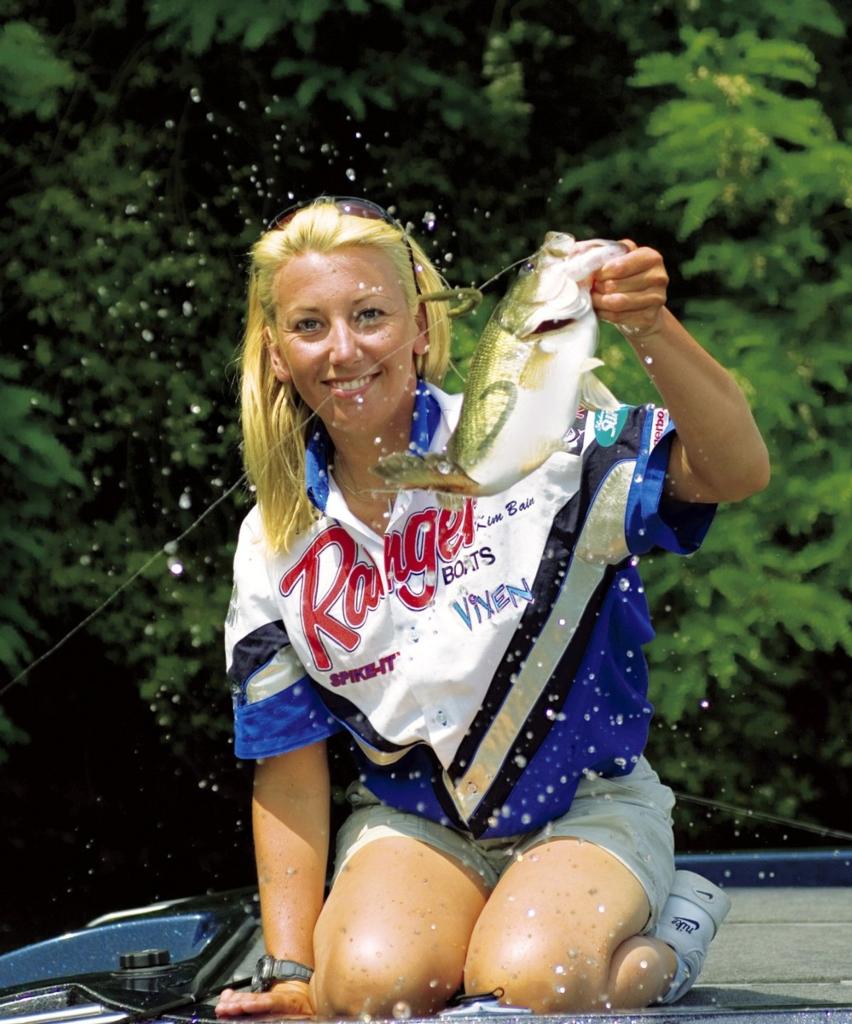
For years, Kim Bain of Brisbane, Australia, dreamed of fishing for largemouth bass in North America. A few years ago the Australian finally got her chance; heading out on the California Delta with new friend, Norval Pimentel.
Bain had no idea what to do.
“Norval said, `Just put on a Texas-rigged Gitzit,'” Bain said. “I asked, `A: What’s a Gitzit? And, B: How do you rig it?'”
After getting the answers, Bain started casting. A few minutes later she was hauling an 8-pound bass into the boat.
“That was my first North American largemouth,” she said, laughing. “It’s still my biggest.”
Beginner’s luck? Maybe just a little.
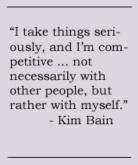 But Bain has always been a quick learner with a rod and reel. The 25-year-old Aussie has proven that fact in her early years of tournament fishing in the United States.
But Bain has always been a quick learner with a rod and reel. The 25-year-old Aussie has proven that fact in her early years of tournament fishing in the United States.
“She’s really good,” said pro angler Andre Moore, who has been engaged to Bain since August of 2005. “Sometimes it drives me crazy.
“We can be out practicing for a tournament, and she’ll be taking a nap or eating a sandwich. Then she’ll get up, make a few casts and catch a fish after I haven’t caught one in an hour.”
After struggling to a 99th-place finish in the standings in her first year as a co-angler on the 2004 Wal-Mart FLW Tour, Bain returned this year and finished sixth – the highest finish ever for a female angler. The run included a 15th in the season-opener at Lake Okeechobee and was capped by a 12th-place finish at the Forrest L. Wood Championship at Lake Hamilton.
Bain didn’t suffer any rookie blues when she entered the Bassmaster Western Open series as a nonboater in 2003. She became the first woman to qualify for the Open Championship, finishing 23rd in the championship tournament that year. She qualified again the next year and garnered a 13th in that championship.
“I was able to back it up,” Bain said. She has finished in the money in six of the nine Bassmaster events she has entered.
Bain, who spends about 10 months a year in the United States, has also fished in walleye and redfish tournaments. In her single foray into walleye fishing, she earned a fifth place in 2004 as a co-angler at the Wal-Mart FLW Walleye League event at Leech Lake in Minnesota. She and Moore teamed up for a 20th-place finish in the Eastern Division Wal-Mart FLW Redfish Series event at Mayport, Fla., April 29-30.
A combination of pride and competitiveness drives Bain.
“I take things seriously, and I’m competitive,” she said. “I’m not necessarily competitive with other people, but rather with myself.
“I just want to do my best.”
The Bain on the boat isn’t the Bain fans see smiling and laughing with friends at weigh-ins.
“It’s like a light switch,” she said of the transformation. “It doesn’t make me unfriendly. I’m just serious.
“On the water, you have to be serious because you’ve got only a certain amount of time to get things done.”
The pros Bain has drawn get to see that first-hand, and not only in Bain’s attitude. On five of 12 fishing days on this year’s FLW Tour, Bain weighed bigger bags of bass than her pro.
“It makes it tricky,” Bain said of out-fishing the pro in the front of the boat. “Sometimes you feel bad.”
Bain knows that the pro, after all, is helping her get into a position to catch fish.
Bain’s fishing ability isn’t the only reason she’s gaining attention. At weigh-ins, it’s hard to miss the attractive, young blond woman with the big smile and the unmistakable Australian accent.
The only Australian on the FLW Tour doesn’t want attention based solely on those assets, however.
“One thing that’s important to me is to not play the `chick card,'” Bain said. She wants people to recognize her first for her fishing ability.
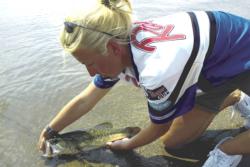 Bain was born into a fishing family. Her mother and father were, and remain, avid anglers.
Bain was born into a fishing family. Her mother and father were, and remain, avid anglers.
“It’s in my blood,” she said of her love for the water.
Bain can’t remember her early fishing trips. That’s because she was so young.
“When she was a baby, I used to carry her in a backpack when I would fish the beach,” remembered Bain’s mother, Lynn.
Kimmy, as her mother still calls her, showed a knack for angling even as a youngster.
One time the family was fishing off the Australian coast in separate boats when both parents hooked up with sailfish. On the boat with their dad, Kim and her older sister, Leigh, asked if they could fish for baitfish while the parents battled their billfish. They were given the OK, as long as they remained clear of the important fight.
“Then I saw this big, black marlin tail-walking across the water,” recalled Lynn Bain.
Kim, who was maybe 6 years old, was hooked up.
“The next thing I knew, this little voice came over the radio and said: `Mom, where’s the tag pole?'” Lynn Bain remembered.
The little girl had the marlin at the side of the boat and was calmly ready to tag it before the release.
The family’s focus shifted from saltwater to freshwater fishing when Kim was a teen. In the 1990s, her dad, Steve, started a freshwater bass tournament circuit in Australia. The target was the Australian bass, a fish that resembles a white bass but behaves like a smallmouth bass.
Bain started fishing the circuit when she was 16, first as a co-angler, then as a pro.
“I did OK,” she said. “But I didn’t have the experience or the wide variety of techniques I needed.
“Most importantly, I didn’t have the confidence yet.”
 In addition to her tournament fishing, Bain was writing for a handful of Australian outdoor magazines and was also working as a correspondent on a fishing show. That career got its start when she was just 14 and asked to write a youth fishing column for a magazine.
In addition to her tournament fishing, Bain was writing for a handful of Australian outdoor magazines and was also working as a correspondent on a fishing show. That career got its start when she was just 14 and asked to write a youth fishing column for a magazine.
“I love fishing so much; I was just looking for a way to make a career out of it,” Bain said. She continues to do some writing when she has time.
Bain was also finding time to travel and fish.
“I would just grab my backpack and fishing rod and go,” she said.
Among other places she has fished are Malaysia, South Africa, Costa Rica and Papua New Guinea. Those trips, both the on- and off-water experiences, helped toughen her up.
“There’s nothing like travel to make you stand on your own two feet,” she said. “When you’re stuck in a train station at 2 a.m. by yourself, you learn to be self-sufficient in a hurry.”
Moore agrees.
“She’s tough,” he said. “I wouldn’t want to fight her.”
With extensive travel experiences, Bain had little trouble convincing her parents that she was ready to travel by herself to the United States to fish in bass tournaments.
“Dad said, `You’re sort of taking over and following my dreams,'” Bain said.
Her mother was also supportive, at least on the surface.
“I was worried, I must admit,” Lynn Bain said. “But she was determined and confident.”
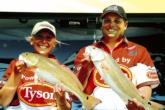 Kim admits that confidence waned as she boarded the plane for the United States.
Kim admits that confidence waned as she boarded the plane for the United States.
“I was really scared and started thinking that I could be making a huge mistake,” said Bain, who was 19 at the time. “I cried.”
Fortunately, Bain had a support network in place, thanks to her dad, who had met Pimentel, who lives in Modesto, Calif., and Bob Adkinson of Washington state during an earlier fishing trip to the United States. West Coast Angler Mike O’Shea has also been very suppotive.
Soon, Bain was fishing in her first tournament, a small team event in California.
“It was hysterical,” she said. “I was so nervous.”
As her performances in the Bassmaster Western opens show, it didn’t take Bain long to adjust to fishing the deep, clear waters out west.
“Then I went to Okeechobee,” she said with a groan.
In that debut on the FLW Tour, Bain finished 133rd. The debacle drove her to learn the power fishing techniques necessary to perform well in the East.
She remains impressed by the backing she continues to receive.
“Everyone has been really supportive,” she said, “from the fans to the fishing guys.”
She credited FLW Outdoors and Ranger Boats for their support.
“They’re very proactive in promoting the female aspect of the sport, and also the foreign anglers,” Bain said.
While learning about fishing in the United States, Bain has also been educating Americans about Australian culture. That hasn’t been easy.
“In Missouri we met this guy who, when he found out Kim was from Australia, said: `Well, you speak very good English,'” Moore said, chuckling.
Bain has started thinking about running her own boat on the FLW Tour. It would be a big step.
“It’s a completely different ballgame when you’re running your own boat,” she said. “It’s a lot more to think about.”
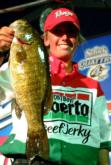 There’s also the issue of getting that boat to the tournaments. In Australia, drivers use the left side of the road, not the right. Bain is still getting used to driving here.
There’s also the issue of getting that boat to the tournaments. In Australia, drivers use the left side of the road, not the right. Bain is still getting used to driving here.
Open-minded means writing it down
Having started her North American bass-fishing career on the West Coast, Kim Bain quickly gravitated to drop-shotting. The technique, for which she prefers using sensitive braided line, has helped her finish in the money in most Western tournaments she has entered.
But after bombing in her Wal-Mart FLW Tour debut on Lake Okeechobee, Bain realized she had plenty to learn about bass fishing in the United States.
She takes a multi-pronged approach to learning new techniques.
“For one thing, I ask for advice from other anglers,” she said. “I also do a lot of experimenting.”
Learning what should work is one thing, but becoming proficient with that method or lure simply requires a lot of practice.
“You just have to tie it on and keep fishing with it,” she said. “Once you catch a fish on it, you have to try to catch another one, and another one.”
Bain also keeps a journal.
“When you face a certain situation, you can look back and see what worked the last time,” she said. “Sometimes it works, and sometimes it doesn’t.
“But it all goes into that bank of knowledge.”
Bain doesn’t trust all of that information to her brain.
“I think a lot of guys just keep it in their head,” she said. “But my memory isn’t that good.”